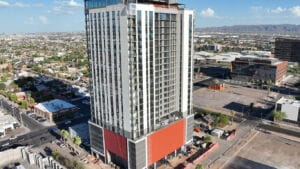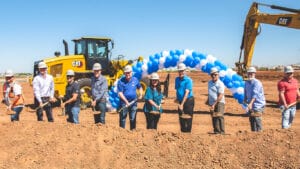The Phoenix data center market continued its steady growth in the first half of 2017, according to a new report from CBRE. Driven by growth in both hyperscale and enterprise infrastructure deployments, the Phoenix data center market remains one of the most diverse primary markets in the country, and has the potential to become one of the leading data center destinations in the U.S.
“Phoenix is a dynamic market,” said Luke Denmon, leader of CBRE’s Data Center Solutions Practice in Phoenix. “Every 18 months or so we see our supply profile change in direct response to demands from different segments within the data center universe. When avoiding natural disasters was the driving force, Phoenix’s data center market grew. Now, the drivers are tied to Phoenix’s lower operating costs and strong regional network infrastructure compared to other markets and Phoenix is still growing. These are signals that the market has matured to a point at which we can shift to accommodate the various nuances of the different user profiles.”
Investment Activity
Investment in the U.S. data center sector reached record levels in the first half of 2017, totaling $18.2 billion, already more than double that for all of 2016 (inclusive of all single-asset, portfolio and entity-level/M&A transactions). At this pace, investment in the data center sector is on track to surpass the total for the three previous years combined.
“Over the past five years, more than $45 billion of investment capital has flowed into the data center sector, with more than 50 percent of that total occurring since the start of 2016,” said Pat Lynch, senior managing director, Data Center Solutions, CBRE. “The robust adoption of rapidly evolving, data-intensive technology continues on a strong upward trajectory and will drive growth in the data center sector going forward.”
Leasing Activity
Nearly 13 MW of leasing activity yielded 3.8 MW of positive net absorption in the first half of the year. The gap between leasing activity and positive absorption was due to a number of new vacancies in second-generation facilities, which dragged down net occupancy gains. As a result, the vacancy rate rose to 8.8 percent in H1, up from an almost unsustainably low 3.8 percent in Q4 2016.
The U.S.’s seven major data center markets—Atlanta, Chicago, Dallas/Ft. Worth, New York Tri-State Region, Northern Virginia, Phoenix and Silicon Valley—combined saw nearly 88 MW of positive occupancy gains in the first half of 2017.
Following a substantial run of multi-MW leases that contributed to record-levels of net multi-tenant data center absorption in each of the past two years, hyperscale Cloud Service Providers (CSP) were largely on the sidelines in the first half of 2017. New leases in H1 2017 were largely by enterprise users with requirements between 500 kilowatts (kW) to 1 MW.
“With the bulk of CSP-related activity occurring as pre-leasing in new data center projects, it’s not surprising that hyperscale users are temporarily focused on building out and deploying their cloud infrastructure,” said Jeff West, director of data center research, CBRE. “Demand from enterprise users will continue this year as they execute their slow-and-steady migration of IT workloads to cloud and third-party facilities. Meanwhile, all indicators are that requirements from hyperscale CSP users will substantially return.”
Major markets are still favored by both hyperscale CSPs and enterprise users, as well as third-party data center operators—a trend that shows no signs of slowing in the near term. Proximity and access to cloud services, as well as to latency-sensitive interconnection nodes to existing networks, are still the strongest drivers of retail/colocation requirements.
Construction Pipeline
The data center supply pipeline continues to accelerate with nearly 284 MW of wholesale capacity currently under construction in the primary data center markets—and 46 percent of that space already pre-leased (131 MW). While pre-leasing levels have consistently been in 45 percent-to-65 percent range over the past several years, there has been a shift in the past several quarters towards speculative development as a result of sustained demand for data center services.
“In particular, hyperscale CSPs are more openly sharing their expansion goals with data center providers to encourage speculative development, as speed-to-market is often a critical factor driving these deployments,” said Mr. Lynch.
Construction activity in metro Phoenix is scheduled to add an additional 28 MW of supply to its current base of 169 MW. Arizona’s potential as a destination market remains strong, as several providers and large-scale users continue to explore expansion and market entry options. An influx of new competitors and a diverse wholesale supply are generally viewed as positive.
“Arizona’s data center incentives program will likely also continue to be an attractive draw for future demand,” said Denmon.
Other markets with significant supply pipelines include Northern Virginia (119 MW), Dallas/Ft. Worth (47 MW), Chicago (41 MW) and Silicon Valley (30 MW).



